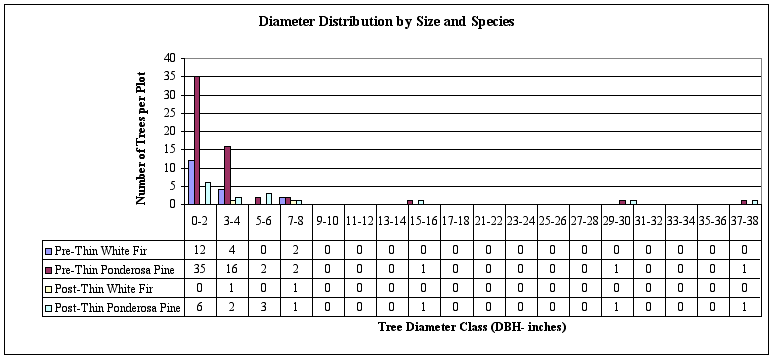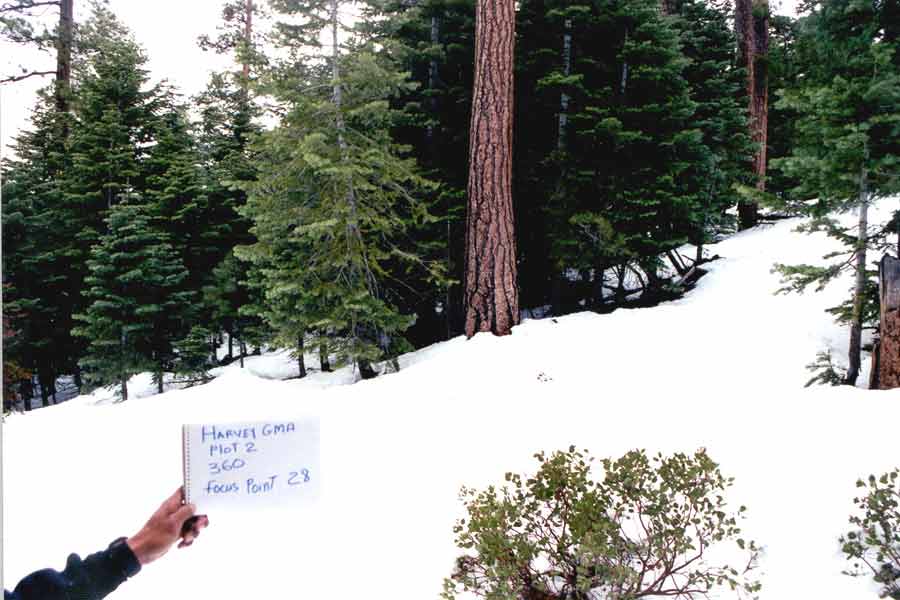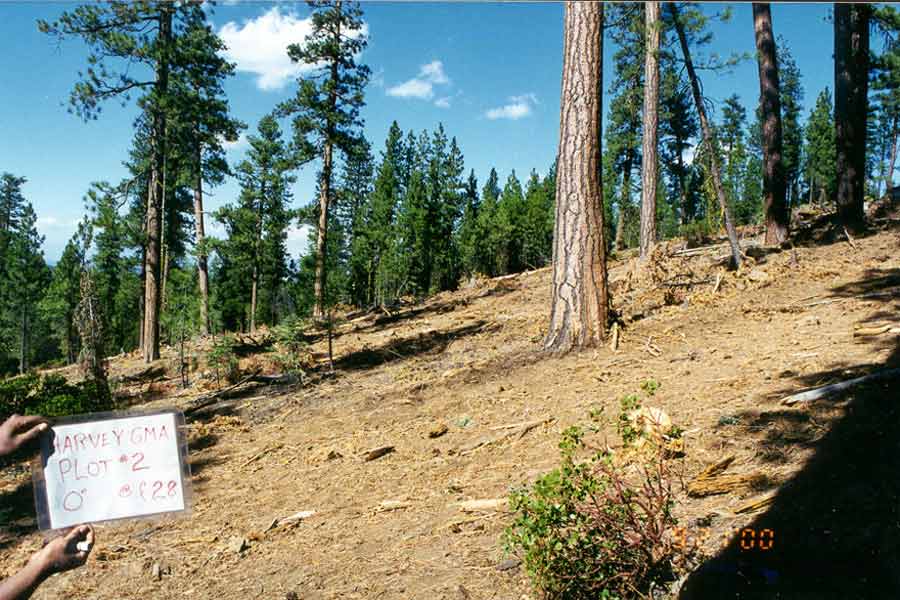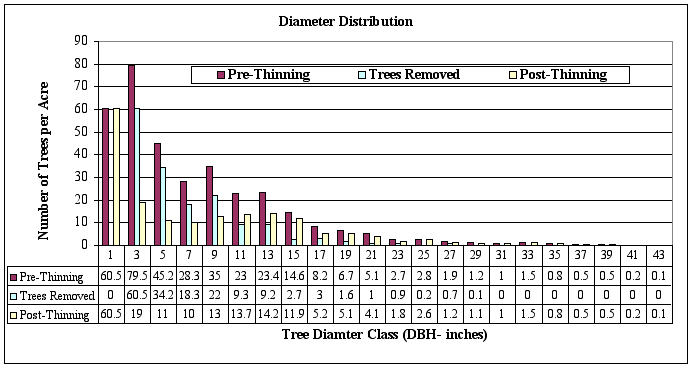The photos and information shown herein were provided by the Eagle Lake Ranger District of the Lassen National Forest. Web page layout and editing by QLG.
The goal of this web document is to illustrate that projects being implemented by the staff of the Eagle Lake Ranger District of Lassen National Forest under the Herger-Feinstein Quincy Library Group Forest Recovery Act of 2000 can be implemented in a cost effective manner and still provide for owl habitat and old-growth characteristics. Important to this presentation are the photographs taken prior to and after the restoration treatment.
The majority of the stands on the District are eastside pine type similar to those shown in the photographs below. The Signal Thin DFPZ sale was awarded in Fiscal Year 2000 and the harvesting began in 2002.
Signal Thin DFPZ Timber Sale (HFQLG). Photo number 1 shows what an unthinned stand within the Signal DFPZ project area looked like prior to thinning. Note that this photo set is not a “before and after” comparison taken at the same photo point.
Photo number 2 shows what a thinned stand within the Signal DFPZ Timber Sale looks likes with a California Spotted Owl Interim Guidelines (CASPO) prescription where no trees greater than 29.9 inches were removed. Most of the trees removed were the smaller trees, that contributed to the ladder fuels in the stand. This thinning generated $125 per acre in revenues and met the defensible fuel profile goals along with forest health objectives. The need to continue with mechanical treatment of similar stands on the Eagle Lake RD still exists.
Non-Herger-Feinstein Quincy Library Group Forest Recovery Act Project Implementation On the Eagle Lake Ranger District, Lassen NF
The following set of photographs represent the type of ecosystem restoration work that Eagle Lake RD has accomplished utilizing mechanical thinning from below. The Eagle Lake Ranger District has been doing biomass thinning for more than 20 years. To date 37,000+ acres have been restored in this manner.
Gooch Small Log Timber Sale. Photographs 3 and 4 are “before and after” photos that illustrate additional mechanical thinning, that occurred within the Gooch Small Log Timber Sale.
These photos were taken within the Summit Lake Old-Growth Retention Area (OGRA), a stand within the Gooch Sale. This particular prescription had a 24 inch DBH upper diameter limit for all pine trees along with a 30-foot radial thin around all old-growth pine. The objective was to enhance the old-growth characteristics while improving stand health and vigor. The stand was classified as E2G or CWHR 3D prior to thinning; it is representative of thousands of acres of similar stands on the District.
Mower Goshawk Management Area or Old-Growth Retention Area (OGRA). This set of “before and after” photos and stand data illustrate what the District accomplished in another Goshawk Management Area and Old-Growth Retention Area.
This stand was mechanically treated with a timber sale embedded within a service contract. The pre-thinning photo (#5) shows that the stand consisted of scattered, large, overstory pine with a dense understory of white fir. It was a typical case of white fir encroachment due to fire suppression and exclusion. The prescription was to thin the pine from below to a 16 inch upper diameter limit and remove all white fir up to a 24 inches upper diameter limit. The objective was to enhance the old-growth by improving the health and vigor of the residual pine and remove most of the encroaching white fir. This project cost $129 per acre to accomplish and met the intended objective.
Mower’s
Old-Growth Retention Area
Plot #2Data
(Near Photo Point #4)
1/5 Acre Fixed Plot (52.6 ft. radius)

The upper diameter limit for removal of ponderosa pine was 16 inches DBH (Diameter at Breast Height) and 24 inches DBH for the white fir. Approximately 18 green tons of biomass per acre was removed from the stand, 35 loads of sawlogs and 65 loads of chips were removed from the 108 acre stand. The contractor bid $197 per acre for services and paid $3.76 per green ton to remove the material from the site. The final average cost per acre was $129. The thinning maintained non-treatment areas that included clumps of small white fir and ponderosa pine. The stand was treated during the summer of 2000.
Harley Small Log Timber Sale. Photographs number 7 and 8 are “before and after” that depict mechanical thinning in eastside pine mixed conifer stands on the Eagle Lake Ranger District. The objectives for this project were to improve the health and vigor of the residual stand while developing a defensible fuel profile zone (DFPZ). The Harley Small Log Timber Sale was a multi-product timber sale that utilized mechanical thinning to accomplish its objectives. This project generated $321 per acre in revenues.
Northwest Harvey GMA/OGRA (Plot #2 360). Photographs 9 and 10 are “before and after” from plot #2, of Northwest Harvey Goshawk Management Area/Old-growth Retention Area. Prior to the thinning this portion of the stand had approximately 480 trees per acre and 158 square feet of basal area (E2N or CWHR 3M). Seventy eight percent of the trees were white fir and twenty two percent were pine. The post-thinning photo (#8) represents 110 trees per acre of ponderosa pine, no white fir and approximately 126 square feet of basal area. The mechanical treatment was accomplished with a timber sale contract embedded within a service contract.
Photos 9 and 10 are from plot number 8.
| Northwest
Harvey GMA Click on image to enlarge |
||
 |
 |
|
| Photo 9: Plot #2 360 2/10/00 | Photo 10: Plot #2 360 9/21/00 | |
The Eagle Lake Ranger District had completed an average of 3,000 to 5,000 acres of mechanical thinning from below using the standards and guidelines in the California Spotted Owl Interim Guidelines (CASPO). Most of these thinnings were accomplished with timber sales and generated significant amounts of revenue. This program will not continue under the Sierra Nevada Forest Plan Amendment. The Bridge DFPZ Timber Sale is a good example of one of these sales. The Bridge DFPZ Timber Sale was sold in August of 2000 as part of HFQLG project implementation during Fiscal Year 2000. Eagle Lake awarded 3,938 acres of HFQLG DFPZ implementation projects as timber sales. All of the sales utilized mechanical thinning and emphasized the removal of the smaller trees in the stand while retaining the largest, healthiest trees as residuals.
CASPO 29.9 Upper Diameter Limit. The table in Figure 2 represents the average trees per acre by size class for all stands within the Bridge DFPZ Timber Sale. The top row in the data table is pre-thinning data; the second row represents post-thinning data. A 29.9 inch upper diameter limit (UDL) was utilized. Most of the trees removed were in the smaller DBH groups and the sale removed an average of 50 green tons per acre while generating $441 per acre in revenues. It is estimated that the crown closure reduction for the codominant, dominant and predominant size classes were reduced by an average of 24% with this thinning. An average of 2.9 trees per acre over 20” dbh were removed with this thinning.
Bridge Thin DFPZ Timber Sale (HFQLG), Eastside Mixed Conifer. Photos 11 and 12 represent “before” and “after” shots of the mechanical multi-product biomass thinning in the Bridge DFPZ Timber Sale within an eastside mixed conifer stand. They are a good example of what the tree distribution in the previous table depicts. As you can see, the objective of removing the ladder fuels (small trees) and leaving the larger and healthier trees was met. The amount of chip material to sawlog material removed is 2:1. It is estimated that the average 2.9 trees per acre over 20” dbh removed with this thinning increased the sale value by $300/acre. The thinning changed the stand structure from Other Habitat (F3G), which is utilized by owls for nesting but not preferred, to Selected Habitat (F4N).
Bridge Thin DFPZ Timber Sale (HFQLG), Eastside Pine. Photos 13 and 14 represent a “before” and “after” shot of the mechanical thinning in the Bridge DFPZ within an eastside pine stand. Again, the ladder fuels were removed and the stand is ready for the planned prescribed fire.
Bridge
Thin DFPZ (HFQLG)
CASPO 29.9 inch Upper Diameter Limit
Tree Distribution by Diameter Class
Eagle Lake RD, LNF
September 3, 2002

Figure 2. Distribution of trees per acre by diameter class (DBH
inches).
Figure 2 shows the average number of trees per acre by DBH class within the Bridge DFPZ Thinning Timber Sale, an HFQLG project. This chart and table illustrates the projected impacts to the trees per acre by DBH class with the thinning. The sale treated 646 acres. This sale generated approximately $441 per acre or $227,742. Approximately 50 green tons per acre of material was removed. It is estimated that crown closures were reduced by approximately 24% in the dominant, codominant, and predominant classes with this thinning prescription.